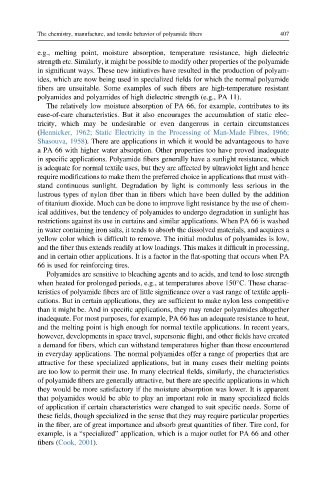Page 434 - Handbook of Properties of Textile and Technical Fibres
P. 434
The chemistry, manufacture, and tensile behavior of polyamide fibers 407
e.g., melting point, moisture absorption, temperature resistance, high dielectric
strength etc. Similarly, it might be possible to modify other properties of the polyamide
in significant ways. These new initiatives have resulted in the production of polyam-
ides, which are now being used in specialized fields for which the normal polyamide
fibers are unsuitable. Some examples of such fibers are high-temperature resistant
polyamides and polyamides of high dielectric strength (e.g., PA 11).
The relatively low moisture absorption of PA 66, for example, contributes to its
ease-of-care characteristics. But it also encourages the accumulation of static elec-
tricity, which may be undesirable or even dangerous in certain circumstances
(Hennicker, 1962; Static Electricity in the Processing of Man-Made Fibres, 1966;
Shasouva, 1958). There are applications in which it would be advantageous to have
a PA 66 with higher water absorption. Other properties too have proved inadequate
in specific applications. Polyamide fibers generally have a sunlight resistance, which
is adequate for normal textile uses, but they are affected by ultraviolet light and hence
require modifications to make them the preferred choice in applications that must with-
stand continuous sunlight. Degradation by light is commonly less serious in the
lustrous types of nylon fiber than in fibers which have been dulled by the addition
of titanium dioxide. Much can be done to improve light resistance by the use of chem-
ical additives, but the tendency of polyamides to undergo degradation in sunlight has
restrictions against its use in curtains and similar applications. When PA 66 is washed
in water containing iron salts, it tends to absorb the dissolved materials, and acquires a
yellow color which is difficult to remove. The initial modulus of polyamides is low,
and the fiber thus extends readily at low loadings. This makes it difficult in processing,
and in certain other applications. It is a factor in the flat-spotting that occurs when PA
66 is used for reinforcing tires.
Polyamides are sensitive to bleaching agents and to acids, and tend to lose strength
when heated for prolonged periods, e.g., at temperatures above 150 C. These charac-
teristics of polyamide fibers are of little significance over a vast range of textile appli-
cations. But in certain applications, they are sufficient to make nylon less competitive
than it might be. And in specific applications, they may render polyamides altogether
inadequate. For most purposes, for example, PA 66 has an adequate resistance to heat,
and the melting point is high enough for normal textile applications. In recent years,
however, developments in space travel, supersonic flight, and other fields have created
a demand for fibers, which can withstand temperatures higher than those encountered
in everyday applications. The normal polyamides offer a range of properties that are
attractive for these specialized applications, but in many cases their melting points
are too low to permit their use. In many electrical fields, similarly, the characteristics
of polyamide fibers are generally attractive, but there are specific applications in which
they would be more satisfactory if the moisture absorption was lower. It is apparent
that polyamides would be able to play an important role in many specialized fields
of application if certain characteristics were changed to suit specific needs. Some of
these fields, though specialized in the sense that they may require particular properties
in the fiber, are of great importance and absorb great quantities of fiber. Tire cord, for
example, is a “specialized” application, which is a major outlet for PA 66 and other
fibers (Cook, 2001).

